It’s been a year of… more lows, mostly? I gather it’s been a record-breaking year for games industry layoffs. It’s also been a particularly brutal year for live games shutting down soon after launch – Concord being the real headline act, following 10 years of development and 2 weeks of operation.
Actually I can take a moment to offer my thoughts on this: Looking at it from the outside, my guess would be the big problem with Concord wasn’t anything to do with the game itself, but the fact they spent 10 years working on it prior to release. The reason why free-to-play mobile games are so generally successful is because developers usually de-risk their launch by releasing the games quickly and in an unfinished state; on an individual level a lot of these games aren’t successful at all, but the failures are cheap to write off and once you release something that looks successful you can pump more funding into it with the confidence that the game has already proven itself in the wild.
I get the sense that the AAA industry has adopted a lot of successful mobile game learnings when it comes to design and monetisation, but not when it comes to the production process? There are established frameworks for developer-publisher relationships that have their roots in boxed products, and I’m not sure that the old models are really appropriate for running a live service game. When I look at a game like Concord… or Suicide Squad, or any of these other big-name games that shut down within months of release… it almost seems like decisions are being made that maximise the amount of risk. The traditional logic that you should invest heavily in development and aim for a big splash at launch seems misjudged. If you’re going to make a live game, the focus should be on the live period, not just the launch day – start small and see if it works before you put more weight behind it, like rolling a giant snowball.
The other key news item feeding into this theory is the one about The Last Of Us Online being cancelled by Naughty Dog after Bungie explained what running a live game actually involves. I play a lot of Destiny, and I watched a lot of Bungie’s GDC talks on their live ops process, and I feel like they’ve developed a good grip on it over the years. I don’t mean to make assumptions about Naughty Dog specifically, but… if some developers from Bungie went down and explained what they actually do – the amount of ongoing daily work involved in running a live game properly?… it sounds perfectly believable to me if established AAA developers would be taken aback by it. It’s a big systemic change of thinking!
I’ve read a LOT of comments from random people on the internet celebrating these failures and saying that it proves that live service games are bad and nobody wants them, but… from my perspective… I’m not sure I’d call many of these games Live Services in the first place. I don’t know enough about the internal workflow and relationships to really judge a particular game, but looking at the way many of these games were managed post-launch, I’m not sure they were really set up for for live ops and ongoing development? So I’m not sure I’d chalk them up as failed live games but more like failed attempts to implement a live service model.
Anyway. Let’s get on with it:

Like A Dragon
I wasn’t sure how I would feel about this – I’m a big Yakuza fan, but had a lot of uncertainties about whether the new turn-based battle system would be any good. Fortunately it is. I think my main observation about it is that, now that your enemies have little titles and nameplates in the UI, you feel much more aware that you’re fighting the exact same enemies over and over again. In the Yakuza games you get used to categorising enemies based on broad classes – like really fast guy with a knife or massive bruiser who is immune to grapples – but in Like a Dragon they have an identifiable class title that you’ll read and re-read many times over.
As for the rest of the game, it’s in keeping with the other Yakuza games, unsurprisingly. The core story is very serious and dramatic, while the sidequests are a series of self-contained comedy sketches. It’s mostly very silly and fun, but also can be very tense and emotional when it wants to be.
I liked the attempts to make it a contemporary take on a fantasy RPG. I think the best example is Namba’s use of improvised equipment to fill the role of a wizard – like spitting a mouthful of burning booze over his opponent to simulate a fireball, throwing a handful of seeds to summon a flock of pigeons and distract his opponent, or using noxious belching to inflict status ailments, but at the same time it feels a bit distasteful in the way it leans on homeless stereotypes. On a different note, I also think that Zhao and Joon-gi Han’s exclusive Jobs feel a bit indistinct and ‘normal’, and Eri Katamaki seems to get sidelined a lot due to her being an optional character – so as much as I like the premise of the contemporary RPG style, I feel like only half the characters are really making the most of it.
My biggest complaint is around the economy. As in Yakuza Zero, there’s a massive minigame sidequest you can follow to become the head of a sprawling corporate empire. Naturally I dropped everything else as soon as I unlocked this and played it for a week straight to get to the end – otherwise I felt like I would finish the game first and never bother going back to do it. But because the top rewards for the business minigame earn you vast amounts of money, I came out of my hole to find that I was halfway through the game but had more money than I could spend.
I went round shops and bought all the most expensive weapons and armour I could find, and the raw stat bonuses they conferred meant that my characters were much more powerful than the enemies in the game were balanced for, which rather spoiled the combat experience because the game felt much easier than intended – a domino effect where one poorly-balanced system spilled out into neighbouring systems, and gradually spread until it the whole game was out of whack. Off the top of my head, maybe they should have put a limit on how much money you can win from the business minigame, per chapter of the game?

Hitman 3
I still have almost no idea what is happening in these games, but I continue to have a good time chewing up each level. The levels are often weirder and more ambitious than in the previous games in the trilogy. I particularly enjoyed the gloomy Dartmoor mansion that seemed to be inspired by Knives Out and other murder mysteries – there’s clear a whole subplot you can explore where you pretend to be the visiting detective and solve the murder (while simultaneously committing your own, of course) but just as I was starting to peel back the layers and get into it I saw a golden opportunity to bump off my target, and I took it and ran.
I also want to highlight the new Freelancer mode – a sort of Roguelike campaign system where you take on bundles of procedurally-generated missions and have to work around strange victory conditions and equipment restrictions. I have yet to actually finish one a whole campaign (you can’t save or load during missions and death is permanent, so one clumsy accident can ruin your whole run) but I think it’s probably the best way to enjoy Hitman – you can’t rely on memorising level layouts and repeating the same cautious techniques all the time, like you can in the main story mode. As with the old Elusive Targets mode you have to grit your teeth, give it your best and live with the results, and I think that’s the most ‘authentic’ feeling for playing as Agent 47.
In some ways I even got to feel like the developers were a little bored of Hitman gameplay? There’s so much other stuff tucked away in the levels – opportunities to disguise yourself as an unusual character and roleplay a totally different kind of gameplay – that it sometimes felt like they were experimenting with ideas for the future. Supposedly they’re working on a James Bond game, which sounds like it would line up perfectly with this – a lot of crossover with Hitman‘s sneaking and killing, but with more scope to explore alternative avenues.

Vampire Survivors (Legacy of the Moonspell & Tides of the Foscari DLC)
When I stopped playing Vampire Survivors last year I had unlocked almost everything available in the base game, and had a good idea what my favourite weapons, items and builds were. I came back to play the first two DLC episodes this year and… prepare yourself for a glimpse into the brain of a Systems Designer… because I had such a strong economy* built up already, I was able to steam right through all this in a few days and quickly put it behind me again.
*(Mostly in terms of the damage economy – in the sense that I had lots of powerful tools unlocked and I understood how to prioritise them – but also in that I was able to earn tons of metagame gold to unlock the new characters and stuff very quickly)
I still find the game a bit dull and repetitive, but I did REALLY like the changes to how levels were designed – all the new stages are complex, intentionally-planned mazes, with different locations and landmarks, specific routes and shortcuts, and sometimes little secret sidequests to unlock certain areas. It’s a lot more interesting and involving than the big empty fields of the original game, and feels a bit closer to games like Castlevania that inspired it – you have an actual place to explore and traverse now, with different zones containing different types of enemy, similar to Dracula’s castle.
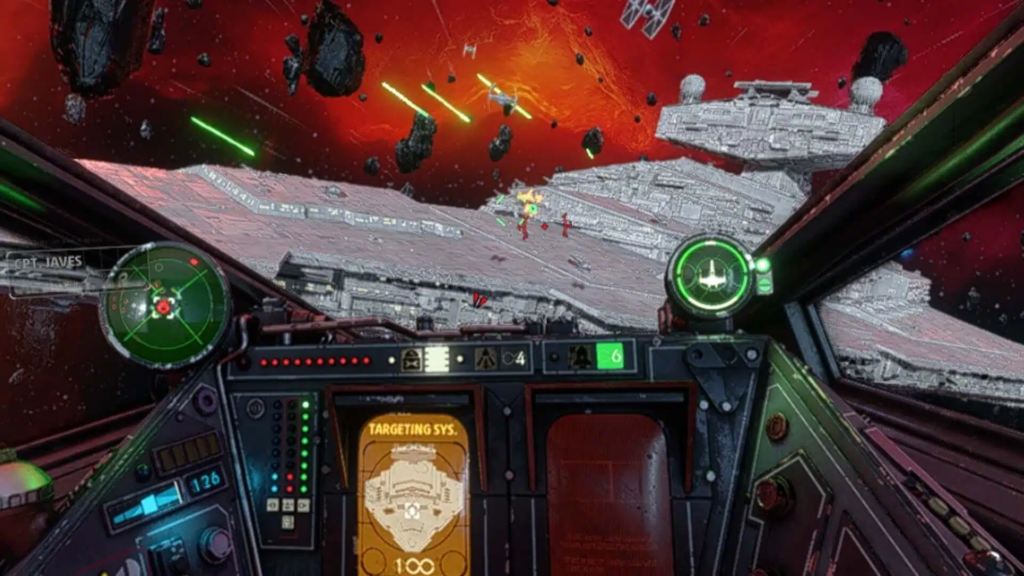
Star Wars Squadrons
There’s a lot to like about the idea of a modern-day spiritual successor to X-Wing vs TIE Fighter – something that reproduces the way people remember the old games looking and feeling, but with modern technology and UX design and stuff – but I think Squadrons does two things that turned me off.
1) The game seems to have been designed as a multiplayer game first, with the single-player campaign mostly existing just to teach you how to use the different ships and weapons. Maybe that reflects the nature of 90’s PC games – during that time when LANs were the only way to reliably stage large multiplayer games, it made sense to make the most of that. You can see a similar approach in lots of RTS and FPS games of the era. Maybe what I’m really saying is just that the single-player campaign came across as a bit of an afterthought? It felt like a long tutorial, and never really took off and became its own thing – none of the levels were particularly memorable. For comparison, Star Fox 64 feels more like Star Wars than Star Wars Squadrons – they do a better job of focusing on the personal dramas playing out within each battle, instead of testing whether you’ve understood how to use your new bomber’s targeting system correctly.
2) I really didn’t appreciate the way the story keeps switching between the Rebels and Imperials. I think it relates to my previous point – the campaign is tutorialising the multiplayer mode, and both sides have slightly different ships and tech, so of course it needs to teach you both sides, but… in terms of the stories being told?… there’s no both-sides-ing Star Wars, you know? Nobody should be rooting for the Empire. It’s sort of necessary when you’re playing as an Imperial in the multiplayer mode, but at least in that scenario you can feel like you’re just fulfilling a role within the narrative of the match. It’s different in a cinematic single-player campaign where your characters have personalities and narrative scenes to set up why they’re going to get in their spaceship and crush dissidents. I could get behind my character during the Rebel missions, and then I’d be switched over to the Imperials for the next few missions and what I really wanted was for my side to narrowly lose each battle. It’s particularly disorienting when you’re playing as both sides in the same military campaign – like you’re trying to defend a facility in one mission, then playing as the other side trying to destroy the same facility in the next mission. I feel like they should have set it up as two separate campaigns – a sincere, heroic story about a band of plucky rebels, or a more ironic, satirical story about a bunch of awful Imperials piling pressure on each other to maintain the status quo.
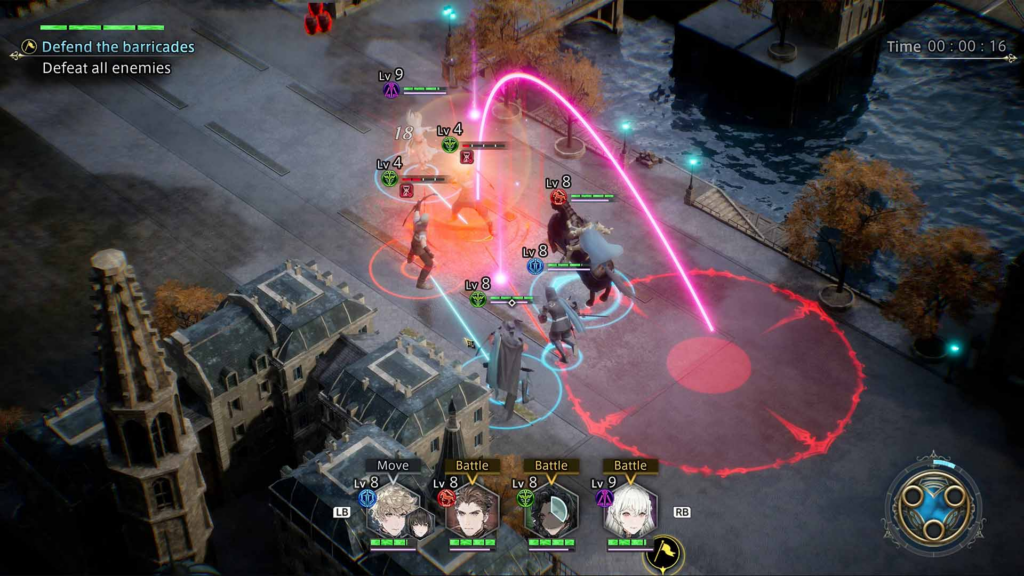
The Diofield Chronicle
I’m always interested in the ways people adapt RTS controls and mechanics for consoles, and The Diofield Chronicle mixes in a lot of RPG style storytelling and character design. It sits somewhere adjacent to Dawn of War II in terms of being an RTS focused on a small number of named characters who operate a bit like units. Great news! I don’t feel like this sort of game has been really figured out yet, but I love seeing people try.
My biggest complaint is about the pace of the game. Every level offers you bonus rewards if you beat it within a certain time limit; you can only meet these targets by playing very aggressively, but once you learn to think in those terms you can easily pick up a lot of bonuses, which help to push your power levels up and make it easier to ride that wave forward through later levels. As a result, it feels like the ‘correct’ way to play the game is to smash through every level like a wrecking ball – if I remember rightly, most missions could be finished in under 1 minute, which makes the game feel more like a puzzle game than an RTS. There’s no time to really react to anything – you just study the starting layout, figure out the most efficient order in which to scrag all the enemies, and then execute the plan in about 30 seconds of playtime, like a cross between solving a chess puzzle and calling a single NFL play.
As a result, I felt like I was spending very little time fighting battles, and a lot of time in my home base watching fantasy anime characters argue about regional politics and lines of succession. I didn’t find the story very gripping. I did enjoy the buildcrafting side of the game – arguably, most of the gameplay takes place in menus between battles as you fiddle with your team’s skills and equipment – but I don’t think that’s ever going to feel like a strong enough pillar to support an entire game on its own.
The final point in my notes is that everyone in this game has a silly faux-English name and I found it very distracting.
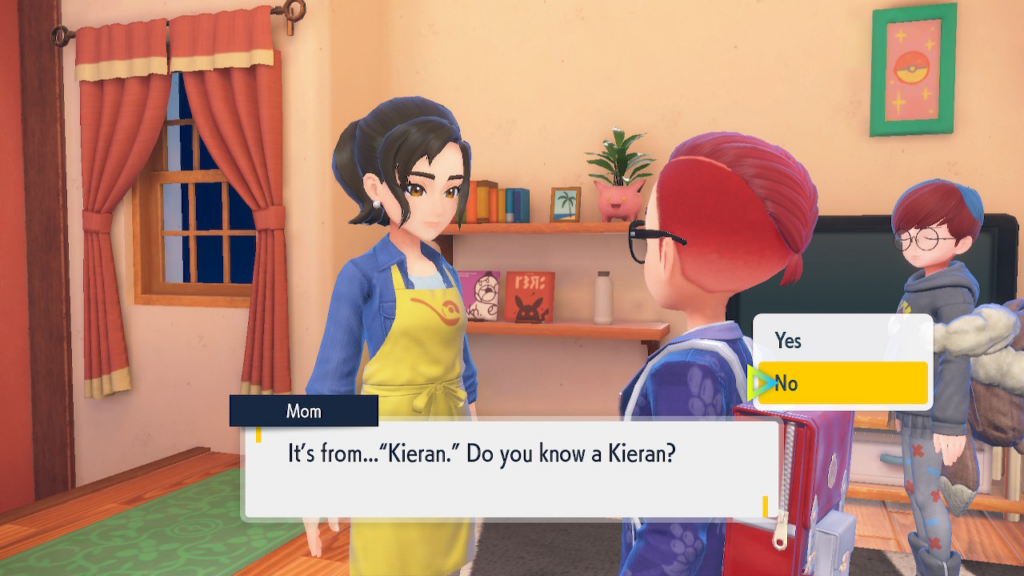
Pokémon DLC – Area Zero Epilogue
There’s a lot of new post-game content in here I haven’t seen yet, but this felt like a weird end to some DLC I didn’t enjoy very much. All your schoolfriends reunite go on an adventure back into Area Zero, but it felt like a weaker retread of the ending of the base game, and the only thing is really adds is a new legendary Pokémon. I still feel like there’s a lot of potential in this new model of Pokémon game, but I think they need to redesign the way threat levels vary around the map, and put a lot of thought into making the environments look better.
Let me start by admitting that there is a LOT of post-game content in this expansion that I’ve barely even looked at. I don’t have enough time in my life to dig through it all. But I did play through all the core storyline stuff (…at least, I think I did all of it…) and these are my thoughts on that.
The Area Zero Epilogue is a strange thing – a free little bit of DLC that ties up some of the loose threads of the previous two DLC episodes while setting up its own little standalone story and introducing a couple of new legendary Pokémon. I didn’t love the previous DLC episodes, but I did like that this story let the different characters you met all hang out together.
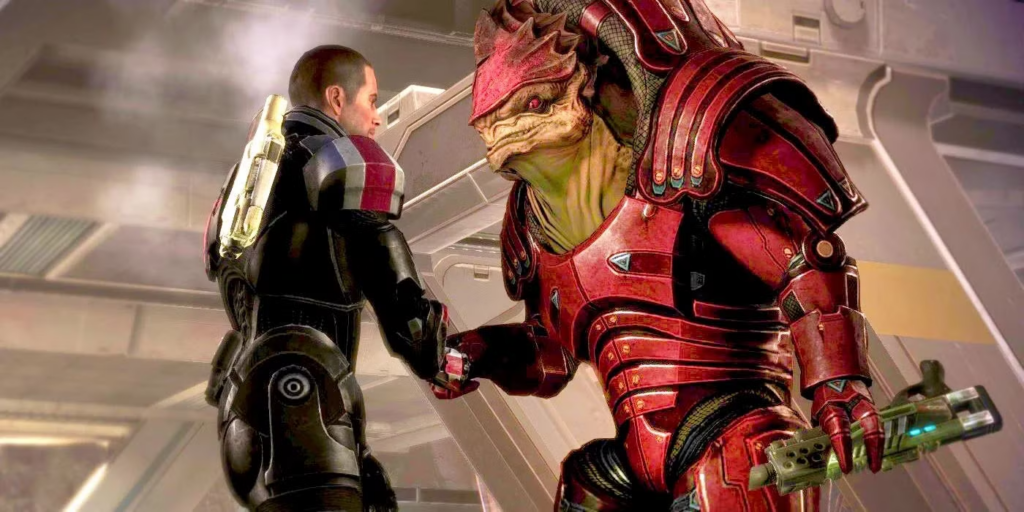
Mass Effect (Legendary Edition)
I’m a huge Mass Effect dweeb – a friend bought me the original game for Christmas in 2007, and I played through it three or four times over the next year. I played through as different classes, making different morality choices, beat the game on Insanity difficulty, tried playthroughs where I did everything as badly as possible, and so on. I think it was the first game I made an effort to get all the achievements for. Having played it a lot, I also feel aware of how short the critical path of the game is.
I’ve been saying for years that I could finish all three games in the trilogy in under 24 hours – it sounds a bit ridiculous to people who have spent weeks exploring all the nooks and crannies and doing all the DLC, but looking at speedrun records it seems like the bare minimum would be around 4 or 5 hours in total. However, I’ve been saying this for so long that I’ve accidentally reached my 40’s and no longer have the necessary youthful vigour to sit up for 24 hours straight, playing videogames and chugging energy drinks. So I thought I might try to prove myself right in a more responsible way – finish all three games in the trilogy in under 24 hours total, broken up across a few weeks of sleeping normally and balancing a normal, grown-up life.
It didn’t last.
That’s not to say that I got sucked in and sat up for 24 hours saving the galaxy, but that I quickly abandoned any pretense of sticking to the critical path and instead spent three weeks meticulously unpacking everything in every game. It’s been about 10 years since I last played the original Mass Effect games (if you ignore that time I played through the Citadel DLC just a few years ago) and once I got started I just couldn’t stop unwrapping things. It was very nostalgic! Not just the characters, but the places and mechanics – that feeling of running through the final mission and using a Lift/Throw combo to punt Krogan minibosses off the map and into deep space brings back happy memories of being in my 20’s.
I still think the original Mass Effect is the best game in the series. The inventory UI is horrible… the whole system of managing your gear, and buying and selling at vendors, makes it difficult to understand what you’ve got and how it compares to everything else. But the story – hunting a rogue space-cop across the galaxy, while your bosses think you’re a loose cannon – the simple, messy combat system (accepting that sometimes you’ll get hit by a glitchy physics attack and ragdoll into an impossible space, dying instantly) and the huge range of weird sidequests that are waiting to be uncovered, all make it a classic for me. There are many things you can point at that could be improved, but I feel like the later games demonstrate the risks of this – how they gradually plane away the rough, messy parts of the game and end up feeling like a glossier, more expensive production, but with less of the charming weirdness that made the original so fun. It was a joy. I had a great time.
Do I have anything interesting to say about Mass Effect: Legendary Edition, specifically? The only thing in my notes is that it seems to use your system-level controller settings in some parts of the game, and a game-level controller settings in other parts. I only noticed this because I was playing the Western version of the game on a Japanese PS4 (where the O button is ‘confirm’ and the X button is ‘cancel’ – the opposite way round to the Western defaults) and sometimes while navigating different bits of the UI I had to switch these round in my head.
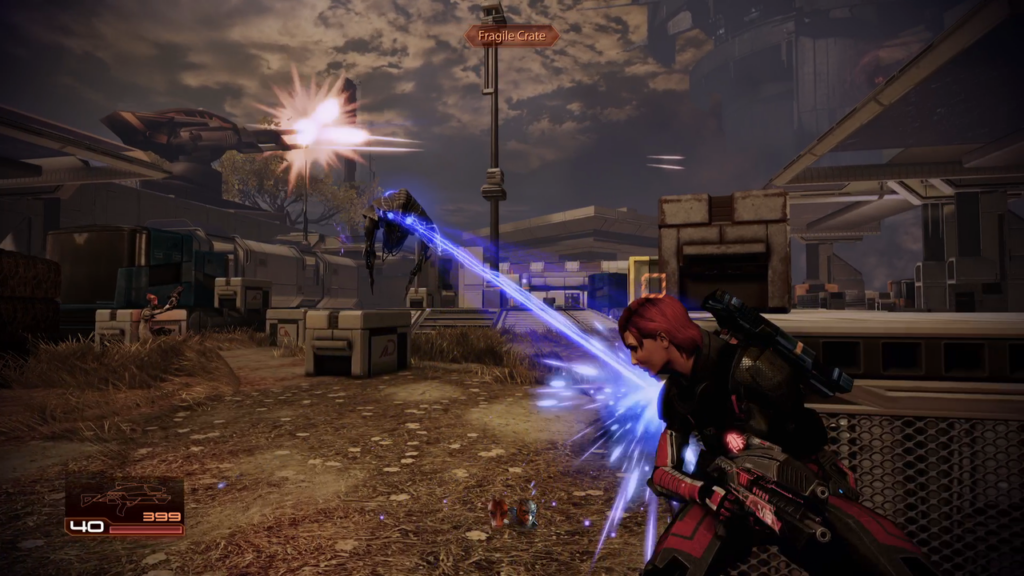
Mass Effect 2 (Legendary Edition)
It feels weird to be writing mini-reviews of the Mass Effect trilogy in 2024, but here we are.
Mass Effect 2 has much more game-y combat mechanics than the first game (eg. different types of enemy shields count as distinct ‘elements’ – psychic barriers, electronic shields, or physical armour – and need to be stripped away using corresponding types of elemental damage in order to leave your enemies vulnerable to your more powerful special attacks) and I feel like that’s about 60% or more of the reason why people prefer it. The first game is a bit experimental and silly and broken, and the second game is more rational and structured and “well designed”, which really sucks a lot of the fun out of it if you ask me.
The combat is more game-y, but it’s also harder. Combat arenas seem smaller than in the previous games, and encounters are designed to pile more pressure on you than before. You’re less able to cheese your way through by launching powerful enemies off the map for an instant kill, so if you’re struggling through the highest difficulty mode you have to look for other systems to abuse – particularly looking for places where you can stand outside of a doorway and kill a few enemies before the scripted combat encounter begins. I feel like it’s the same level of cheapness as launching a miniboss into orbit, but it feels more sterile – like you’re avoiding combat, instead of rolling up your sleeves and abusing it from the inside.
I think the story of Mass Effect 2 is basically fine. Similar to my comments on Star Wars Squadrons, I don’t love the feeling of having to go on all these missions for the sake of an organisation I don’t like, but I think Bioware did a good enough job of writing that into the narrative – the feeling that Shephard can take all the information and resources that their new handlers offer, while doing their best to achieve the opposite outcome to the one they were asked for (…if that’s how you choose to play the game).
The biggest losses are in the sidequests and random exploration tasks. Again, I think a lot of people would disagree with me – there’s no doubt that the little cinematic side-missions in Mass Effect 2 are more interesting, and have higher production values than cruising around on a barren moon in the Mako. But it’s a situation where they’ve chosen detail over quantity – having a small number of good missions instead of a large number of more generic missions – and I think it sucks a lot of the sense of ‘exploration’ out of the game. The old Mako missions have been streamlined into the planet scanning minigame, which is fun for the first half-dozen times, but quickly just becomes a fiddly task you have to tick off for the sake of completion. There is nothing – NOTHING – in this game to compare with the Planet of the Space Monkeys, or the shifty-looking cow who steals your money if you get too close. All I wanted was for them to add some more variety into the planets you land on – the occasional lake, or a town with some NPCs to talk to – but instead we got this. People think it’s better, and they are all wrong.
Anyway. I had a good time! I’ve seen some people complain that Mass Effect 2 feels like a pointless story arc within the trilogy – the idea that you’re just knocking around in space waiting for the apocalypse to arrive in the next game – but I think it’s the appropriate choice. It’s a period where you’re not in immediate danger, but trying to rally the galaxy in preparation for what’s coming. Most people you try to warn don’t believe you, and that kind of tension would be impossible to maintain if it was a game about actually being attacked. You’re trying to mend fences, build bridges, and win people over – it’s like the middle act of Seven Samurai, where all the farmers are gauging how much of a personal sacrifice they’re willing to make over the threat of maybe being attacked by bandits at the end of the summer.
I don’t have many observations about the Legendary Edition remake in particular. I do note that they’ve integrated the DLC into the game quite well – like how bonus missions unlock at appropriate times while you progress through the story – which seems like a good touch.
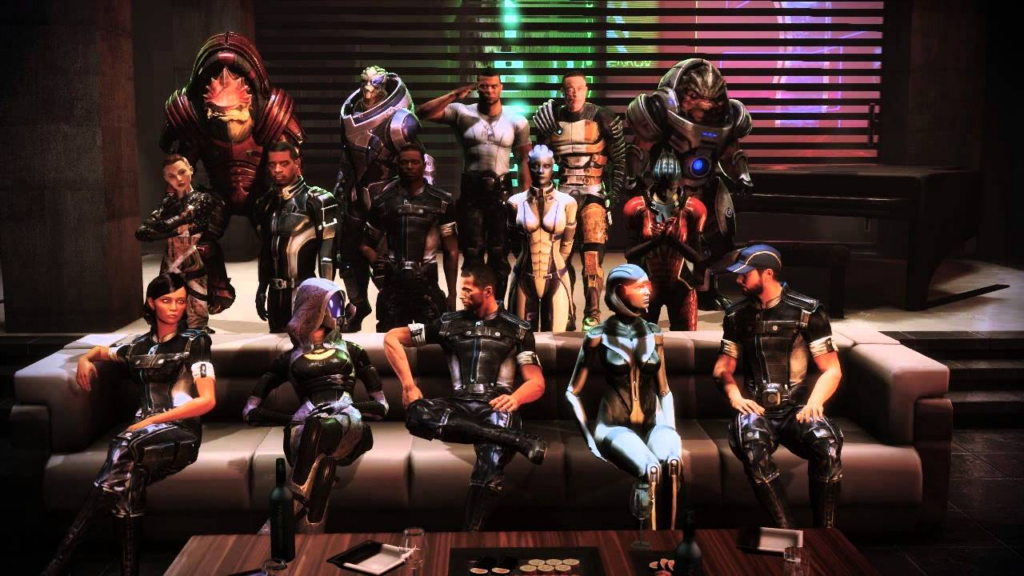
Mass Effect 3 (Legendary Edition)
To outline the opinion about Mass Effect 3 that I have been sharing with people for the last 10 years: I love being able to revisit places from the earlier games and catch up with old characters, but I also feel very sad about how every storyline leads to a definitive ending. The idea of being able to broker peace between the Quarians and the Geth, or to help Mordin and Wrex develop a cure for the genophage, or resolving things with the Rachni (and so on, and so on)… individually, any of these big moments feel like they would make for a nice, upbeat ending to the story, but when you’re doing all of them back to back, on the way to facing down the galaxy-ending threat of giant robot space lobsters? It feels like you’re systematically dismantling all of the political tensions of the galaxy and getting ready to put the Mass Effect universe back in its box, tucked away on a shelf somewhere. There’s some sort of Francis Fukuyama thing going on in the writing, suggesting that since this is the last game in the series we should be able to engineer the end of history – like a situation of permanent, lasting peace that dissolves all of the petty squabbles about who genocided who in the past. I find it more depressing than the threat of the Reapers because I know that by the end of the game I will have turned those guys into scrap metal, but at the same time I – me, myself! – will have turned the social geography of the galaxy into a beige sludge. I like the setting of Mass Effect – not to say that I agree with its politics or whatever, but just that I find it an enjoyable slice of sci-fi – and it bums me out to slowly take it apart. I know that this game is going to be the end of the story, but I don’t want it to be the end of the universe – I would like to imagine my space-friends continuing on and living rich and fulfilling lives after the credits have rolled. The trouble I have is that I perform so many monumental acts of peacemaking in this game that I no longer know what that universe would look like. The actions you take over the course of the game fundamentally destroy the universe as you know it – before you even reach the end, it has already become an unfamiliar place.
I still see people complaining about the ending, and I really just don’t care about it. I once wrote a piece on Midnight Resistance called “Mass Effect 3 Is The Ending Of Mass Effect 3” which summed up my position – the end of the story comes in the form of the 30-or-so hours you spend resolving every conflict in the known universe, not some 10-minute cutscene tacked on at the end. I felt like the three options available in the final choice were all a bit unsatisfying, and I think that’s fine – the point is to think about what you’re willing to compromise on (if anyone cares – and they shouldn’t – I’ve always been a Synthesis guy). As far as I’m concerned, the canonical ending of Mass Effect 3 is to beat the final boss then reload your save file and play the Citadel DLC. You saved the universe, went home, and invited all your friends over for a house party. Lovely! I cannot understand how people on the internet can be so bitter and vocal about a cutscene they didn’t like, more than a decade later. It’s okay to just shrug and ignore it. Roland Barthes said so.
With that off my chest, what else do I think about this game? I don’t enjoy the relentless misery of its apocalyptic setting, although I can also see that it’s maybe a good way to underline that this is the end of the story. I enjoy the novelty of all your previous choices resurfacing through hundreds of tiny interactions – sometimes bumping into characters you haven’t seen since the first game, just long enough for them to say two lines of relevant dialogue – but I think some of those moments feel weird and forced sometimes, and eventually start to break your sense of immersion in the game. I think the changes to combat and class design are good – I like that every class can use a fully-customised weapon loadout now, and there’s a better balance between skill effects. Perhaps the thing I like most is being based back on the Citadel again, instead of Omega?
It’s interesting to play this game through again in the year 2024 and remember a time when new DLC was (sometimes) an exciting and unusual prospect, instead of something that (often) feels like a core business ploy.
I have one specific note about the Legendary Edition, and it’s this: I managed to tick off every achievement for all three games in a single playthrough, except for ONE SINGLE THING where I had to upgrade a gun to level X in Mass Effect 3. There’s a limit on upgrade levels which prevents you from doing this during your first playthrough, so you need to finish the whole game and then start a New Game+ file and play through the first few hours of the game in order to to reach a point where you can buy the upgrades. Why? Who thought this was a good idea?
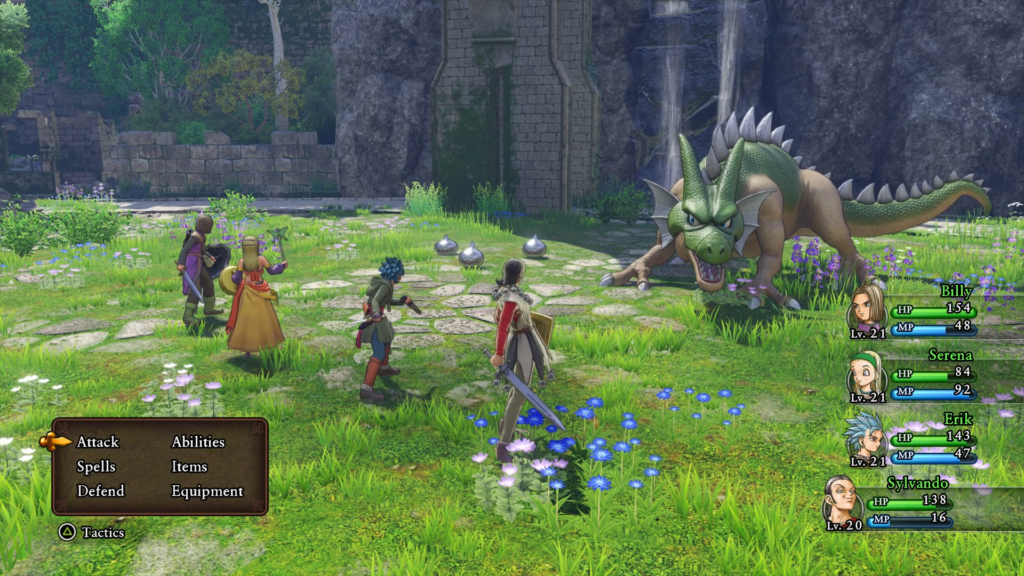
Dragon Quest XI S: Echoes of an Elusive Age – Definitive Edition
I’ve dabbled in Dragon Quest games in the past but never really stuck with any of them – which feels like a totally normal thing to say here in the UK, but at the same time I am aware of how popular the series is in Japan (and hence, relevant to the evolution of RPG design more generally). Maybe this is a sort of follow-up to playing Like a Dragon at the start of the year – wanting to get some sense of the source material that it was in conversation with. I want to enjoy Dragon Quest. I want to understand the appeal, and the cultural contribution of the series at large, as compared to Final Fantasy. It is with this in mind that I thumbed Dragon Quest XI into my Switch (no, I will not be referring to it by its full title) and swan-dived into the rabbit hole. 120 hours later, what did I learn?
I didn’t love it.
I liked the characters, I liked the music (although if I’ve understood rightly, earlier versions of the game don’t have the same fully orchestrated version of the soundtrack) I found large parts of the story totally enjoyable – and some parts were very good! – but I also felt like there was a lot of wading forward just to move things on. I think I would have preferred the game to be about 60 hours shorter, but I can also see that this is partly my own fault – there are one or two early escape points where you finish the basic story and roll credits, but I made the decision to dive back in to do the New Game+ / True Ending style bonus chapter stuff. In fairness, the plot twists in those later acts were some of the best parts of the game; and that makes this a very confusing opinion, in hindsight.
On the whole, it feels like a game that knows what kind of niche it wants to be in, and sticks to it. It’s a modern game in many respects, but there’s also large, core parts of the design that feel 30 years old – as compared to the way Final Fantasy has been so hungry for change that it has spent the last 15 years mutating into a character action game. I can understand the idea of wanting a well-made game that feels nostalgic, but I feel like this one’s not for me.

A-Train: All Aboard! Tourism
I’ve been DETERMINED to get into A-Train for about 8 years now, and this has finally been my big moment. I spent about two months playing it almost every day, and beat half a dozen of the default scenarios. I really enjoyed it a lot, but it feels very difficult at times – this is one of the few games on this list that I didn’t complete.
It felt very easy when I was playing on Easy mode, and then once I cranked it up to Normal it suddenly became incredibly difficult. You have to take the ‘business’ concept seriously – unlike most management games, you have stakeholders in your company who care about the long term outlook of the business. You need to maintain a suitable bank balance, and pay out suitable dividends to keep shareholders happy. The biggest shock always comes when your end-of-year financial report is delivered in March, but your outstanding tax bill is due in June. It felt very confusing at first, but after repeatedly going bankrupt and doing little port-mortems on what went wrong, I came to understand the systems a little better… but I still struggled to find a path through them.
It’s not a very friendly, casual game? At least not on the ‘normal’ difficulty. Growing your network can be a slow, difficult slog – you need to strike a balance between the scale of your train operations and the size of the local economy, and nurture them both in tandem. But once you’ve got your core routes in place and you’re making a nice profit, it becomes more like a virtual model train set, which is nice.
I enjoyed it a lot, and I’m sure I’ll play it some more in future. There’s a lot of interesting design ideas to nibble on and take away – the way that you have supreme executive power to manage the business, but you have to maintain the support of the board of directors, the confidence of the stock market and a friendly relationship with local government, means you are still bound up in relationships with stakeholders who can throw a rock through your plans. They sort of stand in for ‘realistic’ considerations that are usually absent in a management sim, which adds new dimensions to your planning.
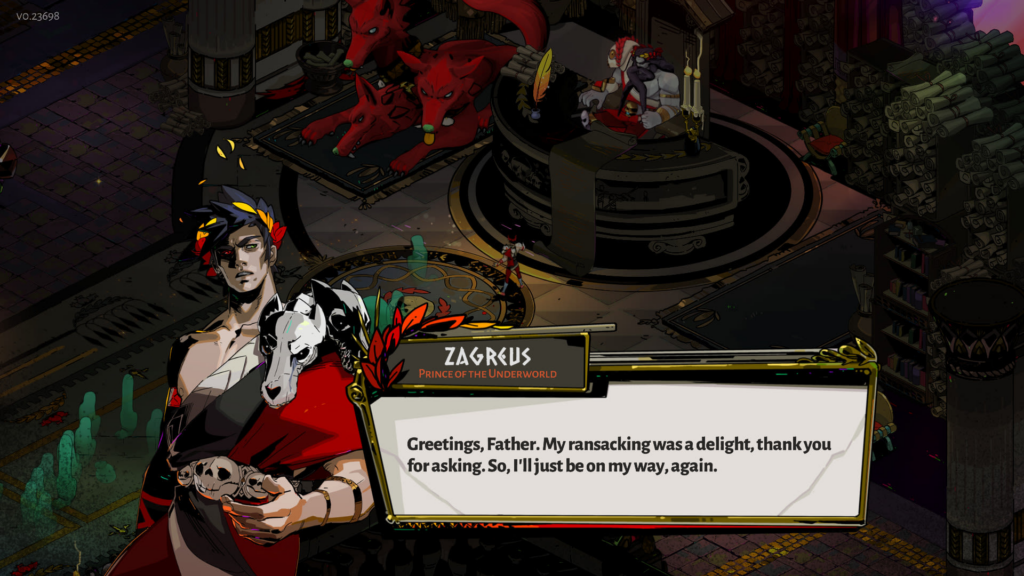
Hades
It was impossible not to notice the enthusiasm around Hades when it came out, but it took me until now to get into it. I found it a little bewildering at first, but got into it more after a few runs – it’s a game that hinges on assembling a strong build out of random component drops, but until you understand the icons and terminology it’s hard to make coherent decisions. So my first bit of advice is: If you try it out and find yourself bouncing off it, maybe stick with it for a while and see if you get over that initial hump.
The masses were not wrong – it’s pretty good. I’ve ‘completed’ the game three or four times now, which by my understanding means I’m somewhere around 1/3 of the way through the main story arc of the game. The different weapons and their respective boon synergies mean there are lots of different ways to approach combat, and I particularly want to call out the way you can lure enemies into environmental traps – I like the feeling of being able to crank up my damage output by dodging in and out intelligently. I do find the bosses often fall a little flat, just because my successful builds are usually structured in such a way that I can steamroll over them without leaving my opportunity for them to express their unique character.
I think the game does a great job of transitioning from the core ‘Complete a Run’ objective to the broader meta-campaign of building relationships, advancing the story and completing challenges. Maybe this is the strongest element of the game – the way that so much of the story unfolds very slowly, and throws in lots of little gameplay twists so the runs don’t become too repetitive.

Metroid Prime 2: Echoes (Metroid Prime Trilogy version)
Part two of my slow campaign to catch up on the Metroid Prime games in preparation for Metroid Prime 4; I generally enjoyed this, but like with a lot of Metroid games I found the later stages a bit tiresome. I doubt that I need to explain this to the kind of person who might find themselves reading my blog, but in a typical Metroid game you are freely exploring an alien planet full of locked doors and impassable terrain, and there’s a certain sequence of discoveries and boss fights that give you the tools you need to open the doors and traverse the terrain, which systematically opens up the map piece by piece, and reveals new problems to overcome. By the time I get to be about 70% of the way through these games, I usually find myself backtracking and roaming around in circles trying to find the next key bottleneck I need to unlock.
I didn’t like the environment design as much as I did in Metroid Prime. I think it’s because so much of the planet is brown and uninteresting – the main zones you explore are a wasteland and a bog, and then a mountaintop fortress (which does at least throw in a lot of interesting lights and interactive features, but also feels a bit like you’re trying to break into a museum lined with restrictive electric fences). But I did enjoy the light world / dark world mechanic – especially the way that you have to open up different entry points, and create bubbles of safe space within the toxic dark world, as if you’re free-diving into an underwater cave complex and need to strategically plan out where to stop for air.
My favourite part of the game was, as before, the different visor modes. I feel like it’s still a little underdeveloped here – you often just flick the other modes on to solve certain puzzles, which makes them feel like a glorified key – but as the game progresses there are certain enemies whose defences are brutally undermined when viewed through the correct lens. Also, I really liked the flying drone enemies who can infect your suit with a computer virus, which makes your HUD go all glitchy and weird until you reboot it.
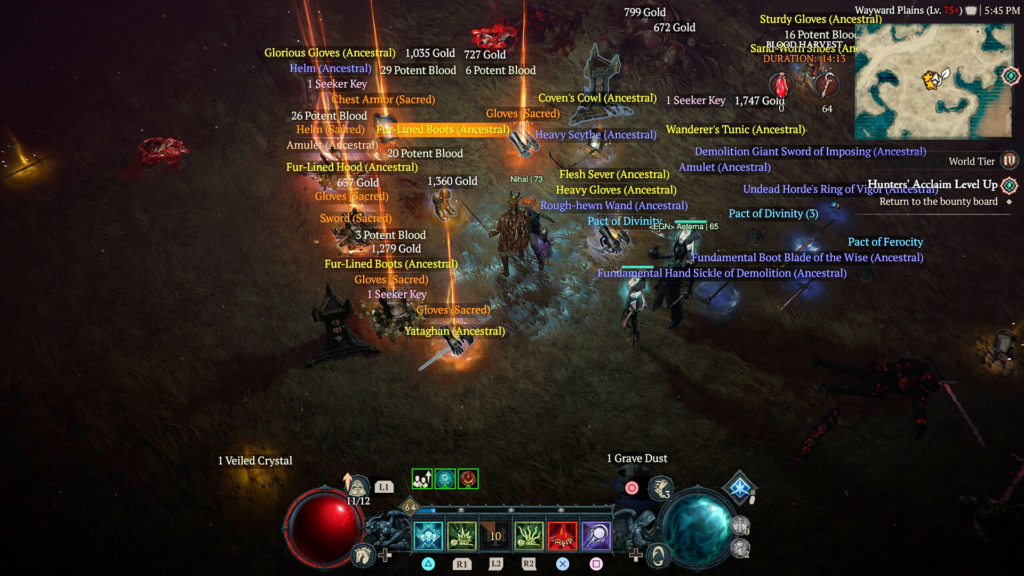
Diablo IV
It was okay. The big, interesting new twist in Diablo IV seems to be that it has one large, contiguous, fixed overworld map (unlike in previous games, where the maps were randomly generated and broken up, one per chapter). I didn’t really see the point of this? In fact it seems to go against the whole procedural-generation USP of the series. Still – it was okay.
I think my biggest complaint here is that it feels like there’s very little variety in how you interact with the world. The world of Diablo is a grim place – each game takes place at a tipping point where the forces of hell are starting to chisel their way out into the mortal realm, teetering on the brink of a demonic apocalypse – and your role is to hack and slash your way through waves of demons, witches, and unholy beasts until you kill their infernal leaders. The combat is the central point of the game, obviously. But there’s a lot of interesting little stories being told around the combat, but the player has a very limited set of tools with which to interact with things.
Perhaps what I’m saying is that the game’s writing is a much higher quality than its narrative design? There are some side quests in this game where the story and dialogue really lands well, but at the same time all my character can do is fight monsters, click through fairly linear conversations, and occasionally click on an in-game object to interact with it – to pull a switch, smash a cursed statue, eat a scotch egg, or whatever. Even the new persistent map / multiplayer architecture is an issue – it’s clear that because the map is a shared, social space, anything that is intended to be interesting and relevant to a single player has to be hidden inside an instanced zone, so you end up doing a lot of sidequests where you travel around from A to B to C in the overworld doing little sub-objectives, and then when the game asks you to step into into a basement you can tell that this is going to be a private miniboss battle to close out the story. By the end of the game, I was really tired of these repeating patterns in the structure of quests.
Like usual, I played through as a barbarian and smashed everything in with very basic attacks. Maybe this is part of the reason why my experience felt a little flat – because I had such a plain build centred on the most vanilla combat experience imaginable? I expect I’ll play through again as other classes at some point, and see how different that feels. What’s more, the system design seems heavily weighted towards the endgame grind – it’s only when you beat the game, reach maximum level and start doing New Game+ kind of things that you start to find the really complex and interesting weapons and armour, which is what you need to really sink your teeth into the buildcrafting side of the game.
I played through Diablo III many times on my Switch, usually by starting a new Ironman character when I went away on holiday and challenging myself to learn a new class. I bought the PC version of Diablo IV and I’m not sure I’ll be playing it as often, since it doesn’t have the easy access and portability of a Switch game. I can see myself going back though, maybe after I’ve picked up some DLC.
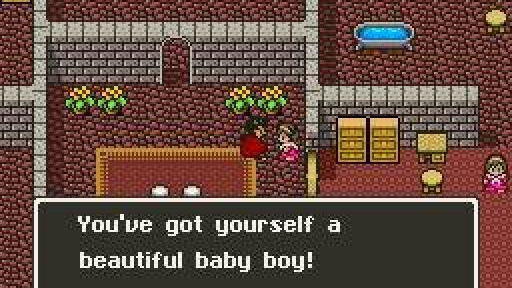
Dragon Quest V
This was another game I didn’t finish, but I got a good ways into.
After beating Dragon Quest XI, I decided to give Dragon Quest V another shot. It does seem to hold up as one of the more interesting games in the series – the main points being that you play through a whole sweep of your character’s life (with the game basically broken up into different Acts set in different time periods) and you can recruit monsters to join your party (which maybe doesn’t sound so novel these days, but I think it was meant to be an innovative twist at the time – my understanding is that this feature was part of the inspiration for Pokémon, although I can’t be bothered to look up whether that’s actually true).
I really liked its ambitions in telling your character’s whole life story! I enjoyed revisiting towns in later time periods and seeing how places and characters had changed… the feeling that you’re watching relationships grow, or social reactions unfold. I think it’s much more effective to let the player spend time with characters, and get some first-hand experience of interacting with them, so they can personally appreciate how time has changed them. In some ways it feels like an early precursor to Fable, in the way that you grow up and get married and have children during the course of the story.
Having said that, I also feel like a lot of what was actually happening in the story was pretty forgettable stuff. Maybe this is influenced by the fact I only got halfway through the game, so my experiences are very weighted towards the early section of the game where you’re playing as a little kid – my feeling was that I was just doing a lot of of generic RPG adventure chunks, without a lot of clear overarching point to it. There’s clearly some more central stuff happening around me, but I think I only really get involved with it during the later sections of the game, which I didn’t reach.
I’m probably going to get back into this and finish it, but it’s going to have to wait a while for me to reorganise my consoles and plug this thing back in.

Thank Goodness You’re Here!
This is one of those games that I’ll pre-order at full price purely for ideological reasons – in this case, to support good, honest, Northern games about good, honest, Northern things. I liked it a lot!
Thank Goodness You’re Here! is a slightly surreal adventure game set in Barnsworth – a caricature of a typical Yorkshire town. You play as a travelling salesman, allegedly, although I feel like your role in the story makes you out to be more like a management consultant, for what it’s worth. In practical terms: you’re a strange little guy who walks around town and solves problems (and sometimes creates new problems) by slapping things.
The structure of the game reminds me of old point-and-click adventures, or something like Dizzy or Cosmic Spacehead where you interact with the world by directly controlling a character, except that in TGYH! there’s no item inventory, so the puzzles tend to have a bit less depth. It’s a short game – at about 5 hours in all, for me – and it’s like tying a rope around your waist and being dragged through a series of hedges by a powerful winch, except the hedges are fetch quests and puzzles wrapped up in slapstick comedy. In abstract terms the basic gameplay is that you just walk around town and slap things, but the joy of the game lies in the humour – the way it plays with setting up expectations and then subverting them, or throws in bizarre stream-of-consciousness diversions.
Barnsworth is a bit grim, but it leans towards Viz style humour (although less crude) rather than something as dark as The League of Gentlemen (well, aside from the butcher’s shop fantasy arc). I’ve enjoyed listening to progressive American podcasters struggling to figure out whether or not the game is punching down on its grotesque residents; I can’t speak for the writers, but I read it as a self-deprecating celebration of life in the post-industrial North.

Unicorn Overlord
Another large chunk hacked out of my giant slab of unplayed Switch RPGs! Unicorn Overlord is a similar sort of game as Ogre Battle. If you want a more recognisable comparison, think of something like a real-time Fire Emblem where you can group a few characters together to form a unit, or a Total War where the strategy map ticks over in real-time but the battles are replaced with smaller, squad-sized autobattles. I was also drawn to the sense of it being a console-first RTS game – long-time readers will know I’m always intrigued by how developers approach that kind of challenge (in case you’re wondering what my observations were: in Unicorn Overlord you have very few units, and the real-time action pauses whenever they get into combat).
I enjoyed it a lot. It touches on many types of fiddly little system that I like: Every character can equip one Class, a few passive or active Abilities and some Equipment… there’s a dynamic relationship system so characters who fight alongside each other regularly can gain little buffs off each other… also you can edit each character’s autobattle logic so you can indirectly control how they behave in combat (which can get very complicated when you’re training five characters to work together – developing a mental flow chart so their abilities trigger off each other and build up into a powerful combo). This game is a real feast for people who enjoy optimising builds.
The story was okay. The events that take place, and the kind of dialogue spoken by the characters often had the kind of generic JRPG tone that leaves me feeling flat, but I felt like there was a lot to like about the world in which it takes place. Vanillaware are known for making games that lean hard on sexy anime ladies with huge breasts and skimpy outfits – an element upon which opinions vary – but putting that to one side I think they do a good job of making interesting fantasy character designs. I liked the visual design of most of the classes, and (mild spoilers??) how the angels and beast-people made interesting contributions to the combat meta as well as having a distinct look.
One final observation I had was that my brain was definitely reaching back to my experiences with The Diofield Chronicle while playing this – there are similar advantages to hitting the right weak points HARD and FAST at the start of a map, before the enemy can get dug in. There are huge dividends to be earned by training up one or two specialist strike units to fly behind your opponents and capture a strategic location or assassinate an enemy commander, while your slower units steadily chew their way forward.
Games Workshop should be out right now looking for someone to make a Warhammer-themed game like this. It sits right in this nice space between the scale of Warhammer Quest and Fantasy Battle – small enough for you to care about individual characters, but large enough to feel like you’re fighting a battle.

Destiny 2: The Final Shape
The Final Shape is (if I understand this correctly) the end of the ‘Light and Dark’ storyline which has been unfolding on an annual basis ever since the original game came out in 2014. I’ve always felt like Beyond Light marked the start of what was essentially the Destiny 3 era, so I suppose by my reckoning the next expansion will essentially be the start of Destiny 4.
Was it good? I guess so. It’s a strange one – the main campaign takes place inside The Traveller, running around a strange, dreamlike environment built out of its memories of previous characters and adventures. It’s a weird setup (although it does ‘make sense’ and more importantly feels reasonable within the weird nonsense of Destiny‘s universe) but it creates a good excuse for this to be like a retrospective experience that recaps the story so far. It only really looks back as far as Destiny 2 (2017) but that’s still about seven years worth of expansion packs that players may-or-may-not have played, so it feels wise that the game world here is like a physical manifestation of a montage of flashbacks. We revisit bite-size recreations of memorable locations from the earlier games, remember the pivotal events that took place along the way, and we redefeat the major enemies who stood in our way.
There’s a vague sense that Bungie are just a bit sick of all the baggage they’ve built up over the years – I’m old enough to remember the rumours about how Destiny‘s original story was ripped out and fully replaced near the end of development, and it’s took them a long time to remedy this (I’d say it only really landed around the time of Beyond Light, when they changed their approach to seasonal storytelling – each big annual expansion would inject new maps, weapons and enemies into the sandbox, and then the seasonal stories would focus in on different secondary characters and give them little story arcs, which helped to shore up the foundations of the game world). In some ways similar to Mass Effect 3, there’s a sort of apocalyptic scent in the narrative – the impression that the writers have been given instructions to tear everything down and create a nice blank slate to start a new story on next year.
In terms of how it plays? I’m not sure what to say beyond it being more Destiny. The main new twist is that they’ve added a sort of customisable class that lets you mix and match different abilities from the other classes – so you could throw a solar grenade, do an electrified melee attack, and use a frost-powered Super Ability. I don’t like it, and in general I try not to use it (the whole point of the campaign story is about you developing this new kind of power, so obviously while you’re playing through it there are lots of times where you have no choice, but once you finish the game and get back to the usual daily grind it’s not really a problem if you go back to the older classes instead)
I still like Destiny, but I feel like it’s been losing its footing in this space between being ‘a game with premium expansion packs’ and ‘a live service game’. Speaking as a person who works in this area, I think I’m quite sensitive to the kind of problems and market dynamics and things that determine budgets and design goals and stuff, for this sort of project. I think it’s something they’re adjusting to, in future – they’re

Super Mario Sunshine
I went on a surprise retro games bent in October, and had another go at hooking up my Wii to my Framemeister in order to play GameCube games with the best possible video quality. I think I nailed it this time! I hovered around on eBay to fill a few remaining holes in my collection, and tried to push back against the creeping winter darkness by playing Super Mario Sunshine.
I don’t think this game is as hard as people make out – although there are some hidden coins that are extremely unintuitive, and some minigames that are brutally difficult. I think it’s true to say that it’s hard to collect 100% of the Shines, but most of the game is very straightforward. In fact – personally – my main opinion about this game is that the hover nozzle makes all of the standard jumping-about far too easy, and that impacts almost the entire game. The abstract sliding block warp zone challenges that people say are too hard represent the only moments where the game is unashamedly Mario-like; the rest of the game is too easy, is the problem.
It sure is fun though?! The last time I played through this game was about 20 years ago (presumably before I got my own GameCube, now that I think about it) and it’s still just as bright and colourful as I remember it. A real pleasure to run around in, at a time of year when it’s cold and dark and raining outside.

Paper Mario
I bought the Virtual Console version of this for my Wii, what must have been about… 16 years ago. I enjoyed Paper Mario 2: The Thousand-Year Door (about 20 years ago…) and I was curious to try the original, and I felt a little better about myself for buying a cheap, official release instead of just playing it for free on an emulator. Back in the day I got halfway through, and then my life got flipped, turned upside-down – I moved abroad, and the Wii got packed up in a box and stashed away under the spare bed at my parents’ house. So more recently, after beating Super Mario Sunshine I was looking around at my Wii’s channel menu and thought this would be a good time to pick Paper Mario up again and tie it off.
It’s a good game, although not as good as The Thousand-Year Door; the script made me laugh and the boss battles made me think. I like that the Paper Mario games usually take strange new perspectives on the Mushroom Kingdom, featuring locations and eccentric characters that wouldn’t normally have room to breathe in a a more mainstream Mario game.
I like the elements of it being a performance, too – little moments that feel like a callback to Super Mario Bros. 3 being a stage play about the events of Mario’s adventure. I think there was once a moment on Insert Credit’s podcast where they said that Mario 3 was the first great videogame sequel, and I feel like there’s something to that, in terms of its significance and lasting impact. (Maybe I’m misremembering this point, but even so I think about it anyway)
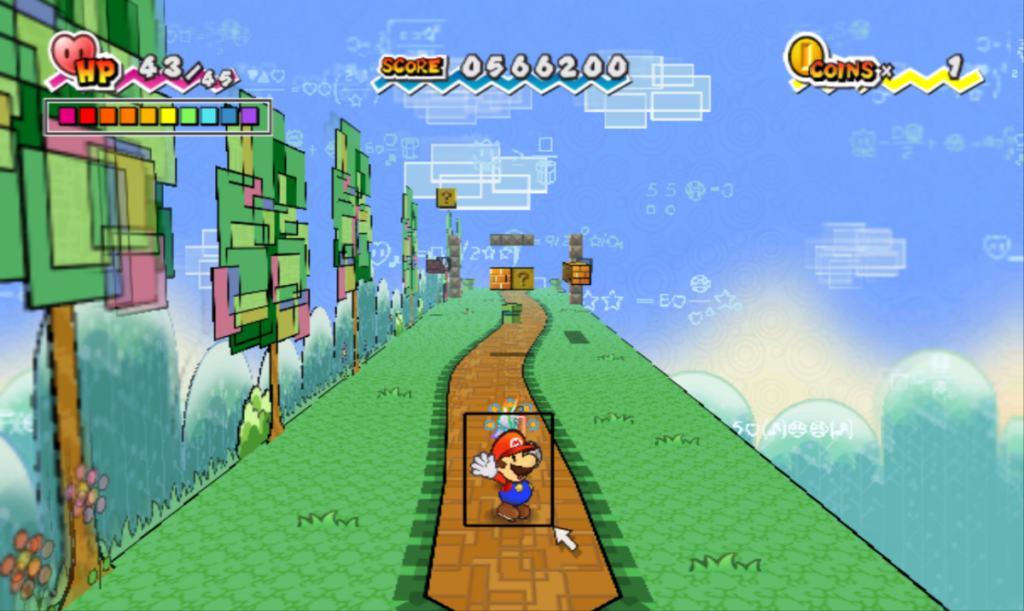
Super Paper Mario
I don’t have a lot to say about this one. It was okay, but it reminds me of PS1-era open-world platformers like Tombi! – I didn’t have to play very far into the game before I felt like I had seen enough. That said, I did stick with it for another week and finished it. I felt like it was trying to stand in a space between being a standard Paper Mario RPG and a 2D Super Mario platformer, and it ended up being a bit underwhelming on both counts.

Doshin the Giant
I was never interested in this game back when it first came out, but I think Peter Molyneux’s arc away from PC god games and into F2P mobile has led me back around to it – I’m hungry for something novel and Black & White-ish to chew on. I managed to find a copy on eBay for £40, which appeared to be a mildly good deal at the time.
You play as a giant, and you clomp around on an island populated by various communities. The islanders want things – like flat ground to build on, or more trees to provide resources – and you can use your giant body to fulfil these requests (by stomping on uneven ground, or ripping up trees and relocating them near their village). Or you can kill the villagers and destroy their homes, as you wish.
Up until this point the Black & White comparisons feel very clear, but in addition Doshin has a real-time clock system which plays out a bit like Pikmin. The giant emerges from the sea in the morning, stomps about on the island for 25 real-world minutes until the sun goes down, then falls asleep and triggers an end-of-day rack-up screen; then the game sends you back to the title screen, and you can reload your save file to start a new cycle. It’s difficult to get to grips with what you’re supposed to actually do during each day. I think the idea is to set up and develop new villages around the map – there’s a sort of villager breeding system in which Doshin can kidnap villagers and encourage them to mate, which is perhaps best not dwelled upon – but there’s a sense of mystical whimsy to the game script which makes it difficult to really lock onto particular objectives. It’s very sandboxy.
As a final note: It’s actually a remake of a 64DD game, which makes it a sort of cousin to the original Animal Crossing in my mind (it being a remake of an N64 game).

Watch Dogs: Legion
I finally bought a PS5, and the first game I played was Watch Dogs: Legion – mostly just because I was so eager to see Liz England’s random character generator stuff in action. The game at large reminded me of Far Cry 2 – another Clint Hocking title – in that there’s a lot of fun interlocking systems, but it also feels a bit too easy to cut out the difficult parts and reduce the game to something quite simple. Most of the game can be played out by flying around town on a hacked delivery drone, and dropping in to attack interior spaces using a spider-bot and some hacking skills. I rarely felt under threat, and despite having this ‘Play as Anyone’ system to support milling through different characters, I mostly just stuck to a few highly skilled hacking specialists for the whole game, and only lost two along the way.
(I think this sort of thing is actually a really central problem when you have a continuous supply of random stuff – the tension between whether to keep changing your loadout and really make use of this steady supply of new stuff, or to find one really good thing and keep using it forever. You see a similar issues with weapon degradation in Breath of the Wild. Once upon a time I was part of a team working on a student project that bumped into this problem too – it was a game about building a Frankenstein, and we had a lot of issues around whether different body parts should come with random stats, and whether we were painting ourselves into a corner where the game could be ‘optimised’ and lose all sense of experimentation, which was sort of what you’d want in a game about being a mad scientist)
I enjoyed its rendition of London – it’s realistic enough to trigger a lot of memories of my time as a student there – but the dialogue felt wrong more often than right. The swearing felt particularly jarring – constantly punctuated by F-words, but never more common, softer, British forms of cursing, like Bleedin’ (at least that was my impression of things, speaking as a person who has barely spent time in London in the last 15 years).
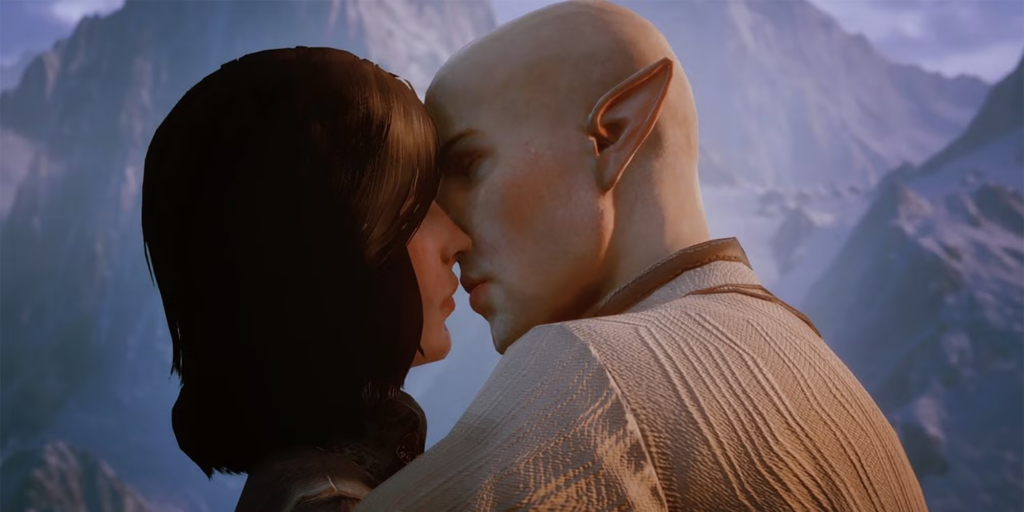
Dragon Age: Inquisition
I finally managed to crack into this, so I could see what people might have been expecting from Veilguard. Inquisition was my first Dragon Age game since Origins about 15 years ago, and it left me almost as cold. Much less grim and visceral, but stuffed with pointless collection sidequests and characters I never really cared much for. I spent some time thinking about why this was such a miss for me when Mass Effect worked so well, and I think it’s partly to do with Mass Effect‘s tighter mission structure giving you a more focused framing of your team’s personalities, and partly because the combat in Dragon Age feels so dull by comparison that my brain struggles to stay engaged with the game. That said, I did really enjoy the ‘Wicked Eyes and Wicked Hearts’ mission – particularly in how conversations became a form of combat, and your social standing became like a new health bar. It was an interesting twist, a bit like the insult-duelling in The Secret of Monkey Island, but with fancy ballgowns.
I did some googling towards the end and discovered that I had unwittingly fulfilled all the conditions to romance Solas, and decided to go with that for the sake of giving the drama omelette an extra whisk.

Tekken 8
I haven’t played a Tekken game properly since Tekken 3, and I feel like this game is marketed towards people like me (eg. costume parts directly taken from it, or the fact Tekken Ball is back). All my old characters are in it except Lei, but presumably he’ll show up in DLC at some point. The game seems fine – there seems to be some new systems where you can trigger canned combos and moves similar to Street Fighter IV‘s focus attacks, and I think integrating them into your playstyle is probably a big change, but I didn’t find them too distracting.
I think the most interesting element was the multiple story modes. There’s the traditional Story Mode – in which the Mishima family continue to try and kill each under the cover of an international fighting tournament with a huge cash prize (although I have to say that the wider plot that has developed across the series, in which the world is now some sort of perpetual civil war between independent governments and some sort of global corporate-despotism governed by the Mishima corporation, seems both silly and depressing). But there’s also a separate Character Episodes mode, which takes a similar format but forces the player to play as the new DLC characters (which I think is a good and smart way to let players try out new premium characters for free, in a limited setting) and Arcade Quest, which takes a step back from the Tekken universe to tell a story about cool teens playing Tekken in their local arcade and slowly moving up the ranks to become world champions.
I think Arcade Quest is a great way to frame a fighting game singleplayer mode – a story that can feel interesting and relevant to the player, without getting in the way of the over-the-top nonsense that the actual characters in the game are involved in. I love that it can serve to teach players about the culture and practices of the fighting game community, and help players to understand the connecting structures between playing a game at home, playing at an arcade or a local tournament, and on to organised tours and professional events.
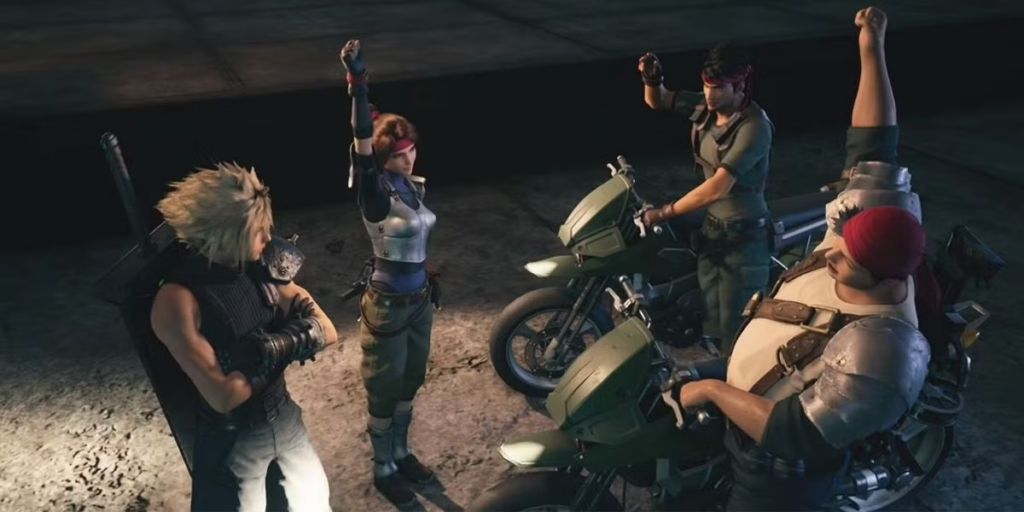
Final Fantasy VII Remake
I loved this, but also I’m going to cheat a little here: I’m going to write a separate article about Remake and Rebirth combined, so I’m not going to waste time talking about it here as well.
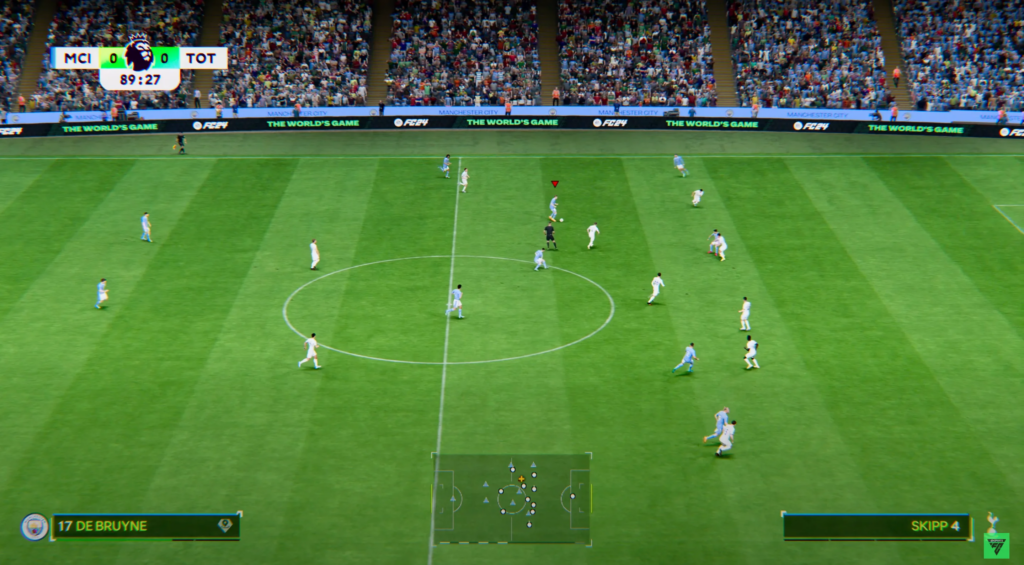
FC24
I’ve barely ever played Fifa, but I felt like I was on a kick of catching up on long-running game series and decided this was time to check in and see what it’s like these days. The single most important thing I’ve learned is to tap the Shoot button, instead of always holding it down and smashing the ball into the stands.
I was hoping there’d be a new edition of its story mode – The Journey – but it looks like they only had that in Fifas 17, 18 and 19. So instead I’ve been steering a young Ron Weasley lookalike up through the Player Career mode and getting to grips with the basics of getting more scores than the other guys.
I’m trying to approach it as if it were a fighting game – I’m here to learn the fundamental systems and controls, like how balance and stamina work, or when and how to use different types of shots and passes. I’m also interested in dissecting the metagame systems, but I feel like the bulk of what I should be learning about lies in FUT and I feel very reluctant to wade back into that (not because I’d find it addictive, but because I already dabbled in Madden‘s Ultimate Team mode a few years ago and I found it very confusing and unpleasant).

Bravely Default 2
Ten years ago I was living in an Airbnb shoebox in Tokyo and playing Bravely Default on my 3DS. I enjoyed it a lot, although I feel like it outstayed its welcome a little (if you kept playing long enough to break into the True Ending stage of the game, anyway). The first thing I want to say about this sequel is that you don’t need to know anything about the previous games to enjoy this – it’s an evolution of the same concept, but there’s no direct story connections or anything (at least, as far as I’ve seen). In most respects it’s basically just a classic 90’s Final Fantasy style RPG, with its signature twist being that when your characters are asked to take an action in battle, they can choose to bank that action point to spend it in the future instead – allowing them to unleash a combo of up to four actions in one turn.
The game feels like a modern take on the SNES-era Final Fantasy games – ATB-based combat, a generic fantasy setting, and characters who can be deeply customised through a deep and complicated Job system. It looks great – big, beautiful painted cityscapes, generally good-looking enemies and character outfits, and a tilt-shift effect in the 3D environments that makes everything look like a dinky model (which I really enjoyed). The story has felt pretty forgettable so far, but I’m still expecting there’ll be an interesting twist coming as they were in the original game. (Update: There wasn’t)
There’s a comparison to be made between Bravely Default 2 and Dragon Quest XI – both games that are pitching themselves as modern takes on a classic 90’s JRPG model. I have to say that I preferred Bravely Default 2 – I’d say it’s a more experimental and innovative approach. Maybe this says something about the freedom of having a younger franchise on your hands?
Looking Ahead to 2025
Oooof. Do we have to look ahead to 2025?
For me, next year is shaping up to be spent bouncing between PS5 and GameCube games. I have Metaphor: ReFantazio, Death Stranding, Elden Ring, and also F-Zero GX, Billy Hatcher and the Giant Egg, Battalion Wars and others racked up under my TV. The main big-name games I’m looking forward to are Monster Hunter Wilds and Grand Theft Auto 6; I’m keeping an eye on Civilization 7 but I’ll probably wait for an expansion pack before I buy it. I would like a Switch port of UFO 50 and I ought to pick up Balatro and Space Marine II at some point.
I will continue to chew through my pile of RPGs. One day I will find the bottom.





Add comment